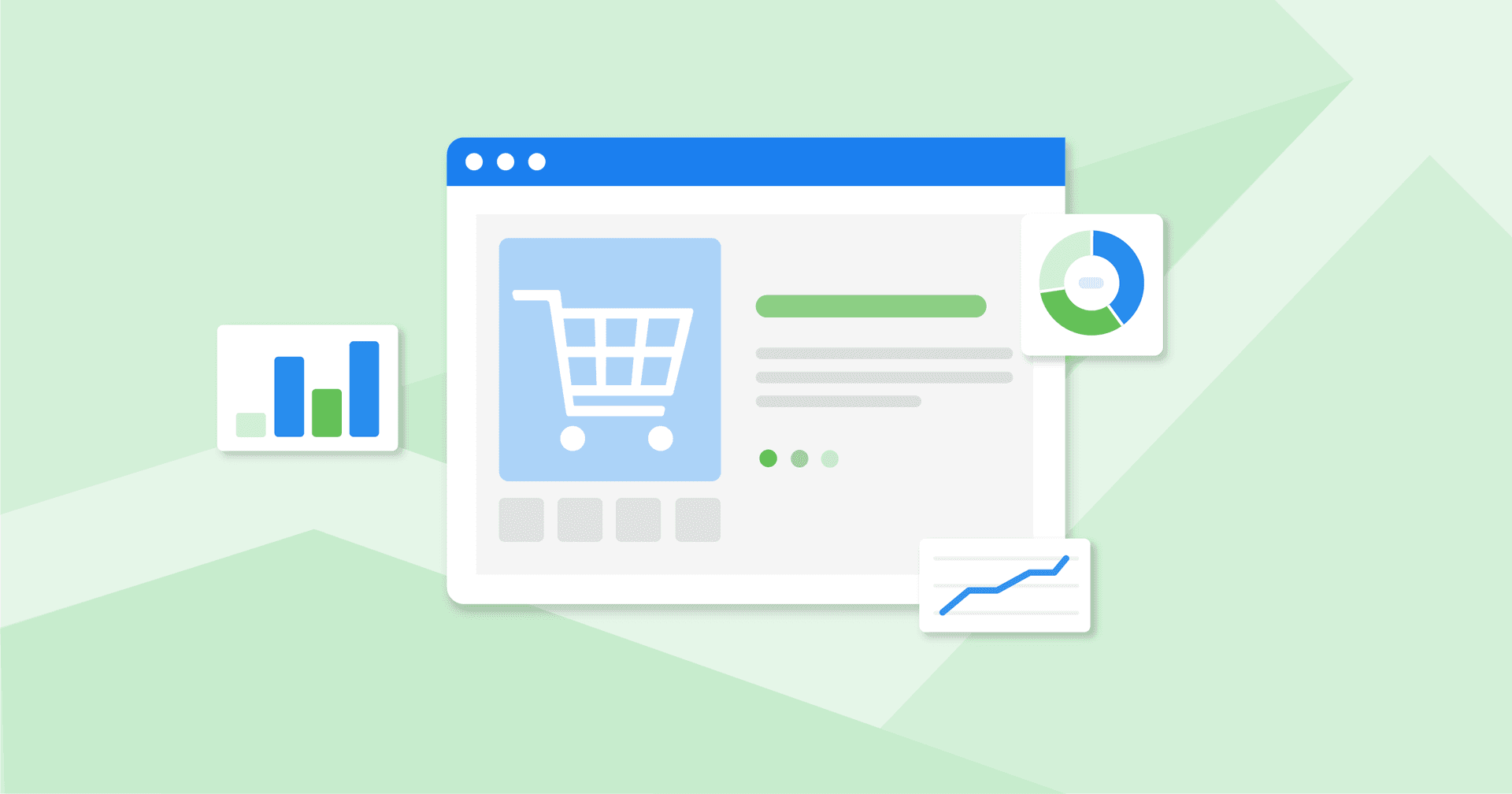Table of Contents
QUICK SUMMARY:
Micro conversions are small actions that users take on a website, providing insight into their journey toward a primary goal. Tracking these actions with a tool like Google Analytics helps refine the sales funnel and improve overall conversion rates.
Creating the perfect sales funnel can be an art, a science, and even, a myth. Every marketer has felt the frustration of having built a killer landing page that doesn’t drive as many conversions as you or your clients expected. But let’s face it–no funnel is perfect. What they can expect from your agency, however, is that you’ll do something about it. That’s where micro conversions come into play.
Since you can’t always acquire a new customer from a first-time site visitor, the real game-changer is what you choose to do with the prospects who fall through the cracks. It’s also what sets successful marketing agencies apart from those who only focus on quick wins. 📈🏆
Tracking your clients’ micro conversions gives useful insights that help you push the needle toward the ultimate goal of potential future macro conversions. Think of these as the process milestones between the initial contact and the end goal. But how do you target each step in the buyer journey in a way that’s scalable?
Let’s explore some examples of micro conversions, why they’re important for conversion rate optimization, and how your agency can make the most of your clients’ web traffic to get more home runs (aka conversions).
What Are Micro Conversions, Exactly?
Micro conversions are the steps that a customer may take during their purchase journey. And they are often underrated. Many agencies think of them as a set of “secondary” actions that a website visitor has taken toward becoming profitable. And being second, they often take the bench during client reporting. After all, your clients really want to know how many new customers they have–not how many fell off the tracks.
But just like any journey, there are important steps that must be completed - providing different micro conversions that can be tracked. Understanding both how many took those steps, and how many stumbled on the next step. These can help your agency fine-tune the full conversion funnel–one step at a time. To fully understand what a micro conversion is, let’s first compare it to the traditional conversion that we all know and report: the macro conversion.
Micro Conversions vs Macro Conversions
Macro conversions, or macro goals, are the actions that your clients want a website visitor to take, and are usually closely related to profit. Types of macro conversions are:
Revenue-based conversions like a purchase or order completion, and signing up for a paid subscription
Lead acquisition conversions like completing an application form or signing up for a freemium membership
Inquiry conversions for websites without eCommerce like submitting contact information for follow-up, requesting a quote, and direct phone calls
Micro conversions, on the other hand, are often not as directly attributed to profit and lead generation and are more related to the individual set of actions a website visitor takes while navigating a website. Micro conversions can be characterized by distinct 3 categories: navigation-based, engagement-based, or interaction-based, as you will see.
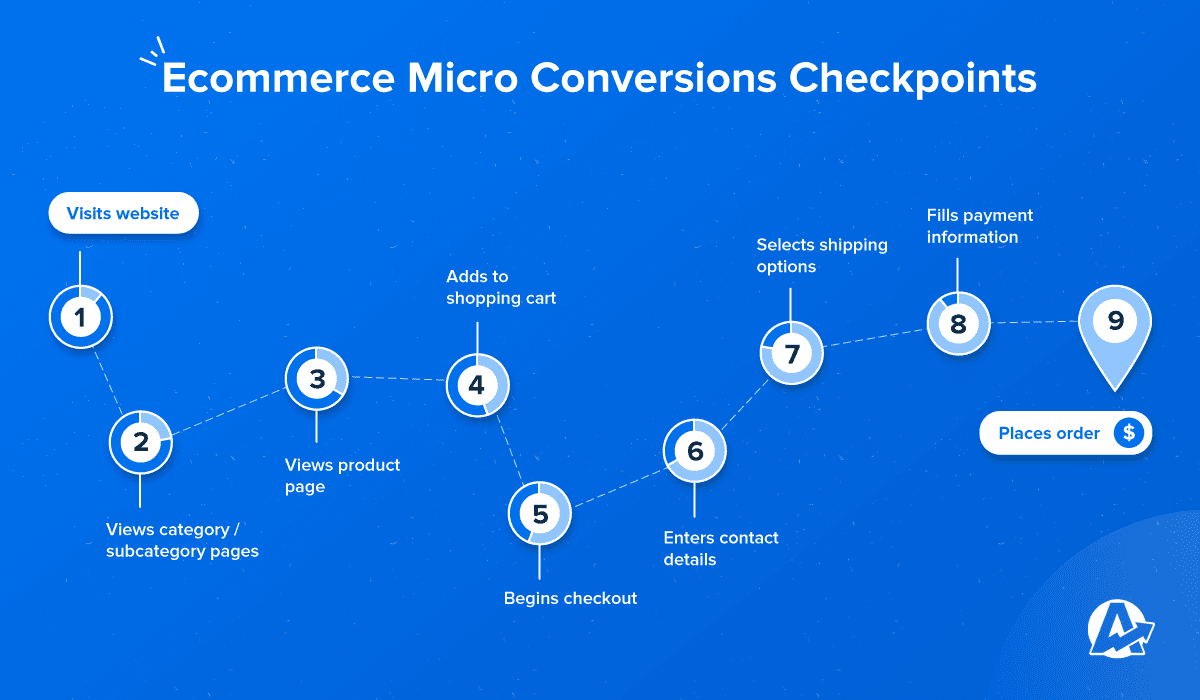
To make things even more complex, some Macro conversions can find themselves downgraded to the Micro level depending on the focus of the client and the agency. For example, a free sample or lead gen form completion can be considered a Macro conversion for a lead gen website, whereas it would fall under a micro conversion for a pure-play eCommerce website that is focused on driving purchases.
Basically, micro and macro conversions connect the dots between key steps between when the user first visits the website and when they place their order can be considered a micro-conversion.
Three Types of Micro Conversions And What To Do About Them
Micro conversions are as unique to your client's business as they are to the buyer journey. When you measure micro conversions, you give your agency deep insights into how to improve the user experience, remarketing, and communications, and boost the primary macro conversion.
Don’t know where to start? Look at which pages visitors are spending the most time on and tie that to the goals and revenue for your client. You can even use heat maps to see where they’re clicking on and further optimize the sales funnel.
1. Navigation Micro Conversions
Navigation-based micro conversions tell you where the website visitors go to. Are they hitting those key pages that will help convert? What needs to be optimized there?
Navigation page conversion metrics are important to track because they are oftentimes the last step before making that purchase or decision: be it perusing the products, adding favorite items in a shopping cart, reading reviews & testimonials, or filling out contact details (if the website isn’t an eCommerce site).
These micro-conversions often occur just prior to the ultimate goal–it’s so close, you can just feel it! Let’s take a look at what to do with this information… Let’s take a look at some of the most common navigation-based micro conversions:
Time Spent on High Intent Pages
Viewing a product page can be a strong indicator of high purchase intent. The visitor is clearly pursuing your client’s offering. It’s the equivalent of window shopping in the digital age. Ensure it looks good: Use quality images of the products, and even videos to highlight the product. Since they can’t see it in person, the images should be high def and allow the Zoom-in option to build trust.
These visitors are also ripe for a well-targeted remarketing campaign to remind them of the key features and benefits of your client’s product or service. With so many retargeting options available now through search, display, and video, this is a high-ROI opportunity that should not be missed.
Entering the Checkout Process
This one has multiple important roadblocks to optimize, as it is the only thing holding you from getting that home run.
Are a lot of visitors entering the checkout process but not completing it? Think about what might be stopping them, and discuss this with your clients on how to best resolve these easy fixes to push more micro conversions into becoming macro conversions. Below are some common examples:
Roadblock #1: Low-quality thumbnails on your checkout page
Best Practice: They need to be sure that they are receiving what they ordered
Roadblock #2: Additional costs getting you down? – Perhaps the shipping costs and taxes deter them. In a recent study, 55% of potential customers stated that the reason they abandoned their purchase was because the additional costs were too high.

Best practice: Provide as much info on pricing as you can before they reach this phase. Full pricing info on the product pages, and estimates with their geographic location will help your clients show transparency and save a lot of frustration on both ends. Also, shoppers LOVE free shipping-so consider proposing that as an option to your clients.
Roadblock #3: Account creation required
Best Practice: Always ensure guest checkout options, and worry about the registration details later.
Roadblock #4: The checkout is too long – see point above.
Best Practice: Reduce the number of pages it takes to check out. Plain and simple. Use the help of integrations to streamline the checkout process.
Roadblock #5: They don’t trust the payment methods
Best Practice: Provide high-level security for customers by following PCI compliance guidelines and take advantage of badges and testimonials that attest to the customer care and quality of your clients’ services.
Metrics to Track:
Time spent on high intent pages (ie. product or service overview page)
Time spent on key conversion pages (ie. checkout page, free trial signup, or quote/demo request)
Number of visits to purchase supporting pages (e.g. reviews or testimonials)
Number of times they visited a lead-gen form (if the site is not eCommerce, but lead-gen oriented)
Clickthrough rate (CTR) from a SERP (did the ad do its job, and is it what they wanted?)
By identifying critical navigational micro-conversions using the metrics above, your agency can easily identify and then fix the weakest parts of your client’s sales funnel. For example, if 60% of prospective customers are dropping off at a particular page in the purchase funnel, reducing that to 30% can drive a significant increase in conversions and revenue. Making UX improvements by addressing the barriers that are blocking your visitors from reaching the finish line is an excellent way to turn micro-conversion insights into real value for your clients.
2. Engagement Micro Conversions
These common micro-conversions indicate how much time was spent on your clients’ website/pages, as well as how many times they visited their site. The website visitor’s actions can include:
Visiting a specific category or sub-category page
Adding an item to their shopping cart
Starting the checkout process
Entering contact information or delivery address
Selecting the shipping options
Filling in the payment details
Metrics to Track:
To measure the micro conversions above, you can track the following metrics:
Amount of time spent on a page or website above a certain threshold
Number of pages viewed above a certain target
Frequency or recency of visits above a certain target
The metrics above indicate that a certain visitor is highly interested in what your clients are offering. These can be tracked in a web analytics dashboard and used to optimize individual web pages.

By capturing these engagement-based micro-conversions, your agency can design and deliver a much more targeted and segmented communication strategy to bring these users back to complete their purchases.
3. Interaction Micro Conversions
Interaction micro conversions dictate what a website visitor did while on a page. The more time a website visitor spends on a website the better because what they do on the pages, as well as how they interact with your client’s website helps determine their intent.
But what are these high-intent actions? To answer this, you’ll need to revisit your client’s customer journey and answer: what is likely to drive website visitors towards the end goal? Let’s take a look at examples of what agencies can do with common interaction micro conversions:
Live chats initiated by the user
Live chats work: 79% choose it to get their questions answered immediately, and 73% prefer the live chat option as opposed to email (55%) and phone (44%). And time is money. In fact, most people say they prefer to chat with a bot rather than talk on the phone with a sales rep. Ensure your clients have a dedicated customer service team responding in a timely manner, or help them set up chat automation. Not convinced? 39% of live chat usage is to create sales prospects.

Adding a product to the cart
Did they add a product to the cart and then abandon it? Hello, automated, personalized reminder email! You’ll see this a lot in eCommerce: How many times have you gone back to a site, filled that shopping cart, abandoned it, only to return again, and put some more items on your Wishlist? 🙋♀️ Guilty. And I know you do it, too. According to Cloudways, the cart abandonment rate is at 76% globally.
We might make a purchase at some point. But what will drive that sooner or later are the follow-up actions that the website decides to take to pull us back in to purchase? For me, that’s a combination of scarcity and FOMO (“Oh no! There’s only 1 item left in the entire world and now’s your chance!”) and Initiative (“Here’s a free Coupon!” or “Order now for delivery by x date”). These are excellent motivators for CTAs, might I add.
Many brands are getting more creative than ever with their reminder emails. I’m sure they have some creative agencies behind them to improve their shopping cart abandonment rate conversions:
Exhibit A: eCommerce for Cat Food
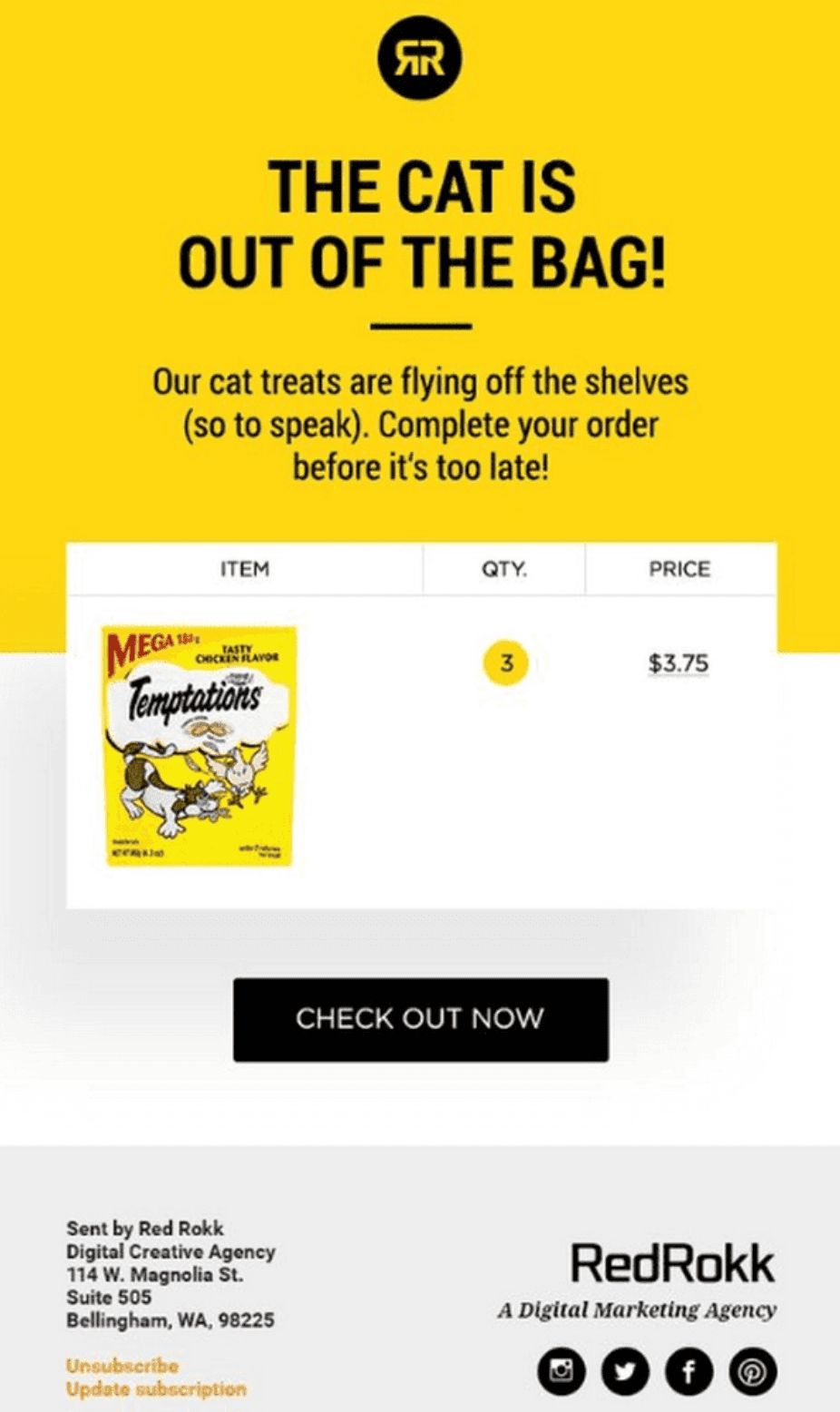
They seem to be taking the humorous route to not be annoying. Others opt for the friendly reminder tone:

Depending on your client’s audience, either are good ways of sending action-based email automation for the infamous case of shopping cart abandonment.
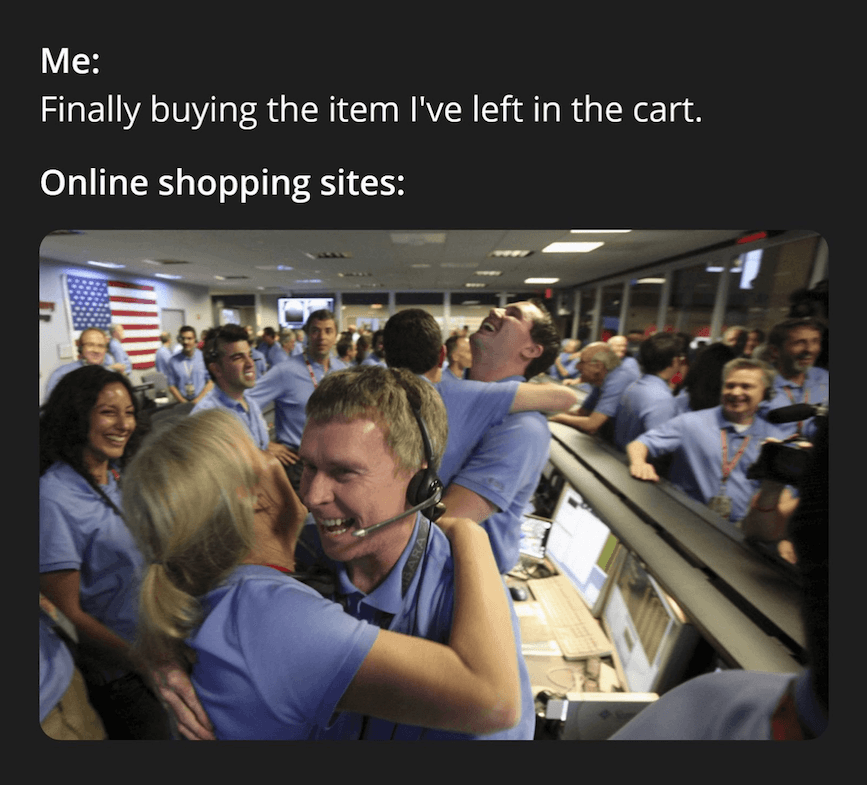
Read more: How to Build & Optimize an ECommerce Sales Funnel
Downloading a PDF brochure
This is a classic freebie acquisition model for a reason. They wanted information specifically about what you specialize in. Let the email nurture campaigns begin!
Social actions
Have they looked your clients up on Instagram and given a follow? Did they share your content? Did they send your product to a friend or family member via Facebook Messenger? If so, they’re almost begging to be friends, if you only show them how easy it is! One option is to set up Google Analytics micro conversions. Another option is to set up goals in your social media dashboard for any metric of your choice. More on this below.
Read more: Cut Through the Confusion in Google Analytics by Looking at These Metrics
Watching a promo video
Wait, this person actually took time out of their day to watch you? Get back to them with retargeting and track it in a dedicated PPC dashboard and reporting system.
Requesting a callback
This one is almost a done deal. So much so that many companies consider this to be a macro conversion. But, if your client does not, use call tracking software for agencies so your clients never miss out on a lead.
Metrics to Track:
Pageviews (particular key funnel & product pages like: Form views, Contact Us page visits
Bounce rates
Time on page
CTR
Knowing that the average amount of time a user spends on a website is just over a minute (62 seconds) leaves you with little time to grab their attention–and keep it. But what's important is also to track the high intent interactions and convert those into the desired actions that will nudge the visitor in the right direction.
Agency Tip: Add an interactive element to your clients’ landing pages. A/B test pages with videos and GIFs to see how time spent on key pages goes up! Creating memorable experiences not only captures peoples’ attention, but is also key for brand messaging retention.
To scalably track micro conversions for all your clients, you’ll need to ditch those manual client reports and use a robust client reporting software that easily allows you to set custom goals and track the metrics behind them–automatically.
Harnessing the Power of Micro Conversions in Your Client Reporting
Putting targeted conversion optimization efforts into each part of the funnel makes for a seamless user experience and buyer journey. Let’s take a look at how to harness the power of tracking micro conversions: Goal-setting!
Using AgencyAnalytics’ Custom Goals feature, easily set up the conversion metrics you want to track for your clients. For example, if your agency knows that 10% of customers who request a quote end up purchasing or 2% of users who sign up for a client’s newsletter will buy, you can set a specific goal for the # of quote requests or newsletter signup micro conversions your agency should deliver each month to reach the macro conversion targets. AgencyAnalytics integrates with over 60+ marketing channels, so your options are endless. The hard part is deciding which micro conversions to track for each client, and how.
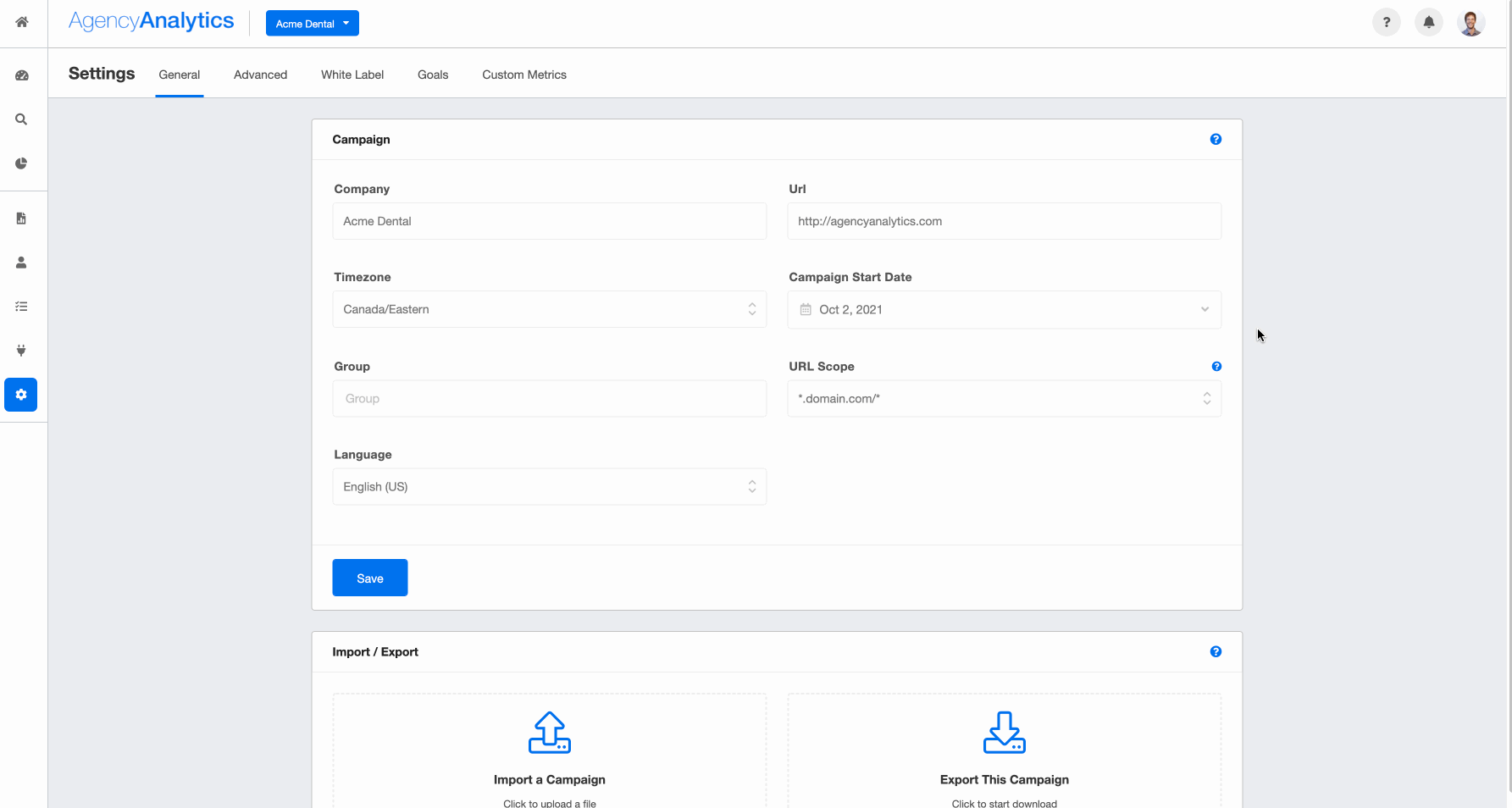
Another option is to set up your micro conversions directly in Google Analytics, and drag and drop that widget into your dashboards and reports. Et voila! Customized micro conversion tracking.

Read more on goal setting in Google Analytics here: The Ultimate Guide to Getting Started with Google Analytics
You might be tracking conversions in the back end, but how can you deliver your successes to your clients in a way that’ll make them care? The trick to showing the value of micro conversions in your client reporting is to show that you’re moving towards a long-term plan to convert existing visitors. Also highly consider leveraging AI for conversion rate optimization to greatly speed up execution.
TL;DR - Add Micro Conversions to Your Client Reporting and Showcase Your Wins
What agencies can (and should) do is nurture their clients’ prospects using intelligence acquired along the buyer journey. By tracking users’ secondary actions, micro conversions, if you will, agencies can harness the power of new prospects and nudge them in the right direction using on-site conversion tactics, email marketing, retargeting, and more. Just as fixating on a single metric is not a good idea, thinking that all micro conversions will lead to a macro conversion is also myopic. Agencies need to test, track and think in the long term.
Micro conversions are an essential part of your funnel, but often get discarded in the reporting phase. Falsely deemed less important, they actually have excellent insights that can:
Prevent losing customers between the cracks in the funnel
Give interesting A/B testing opportunities to further hone in on the buyer’s journey
Offer a level of personalization in your clients’ marketing strategy/plan
If you only track the end result, you won’t know how they got there. Tracking the actions that lead up to a goal completion helps put marketers into the buyer’s psychology–allowing opportunities to improve the UX every step of the buyer’s journey. Make the most of your clients’ website visits and hone in on those goals. Clients will appreciate your attention to detail– and demonstrating more wins is what will set you apart from the competition and show your value.
Don't drop the ball on your clients’ new prospects. Aim for the home runs, but understand the value of making it to each base.
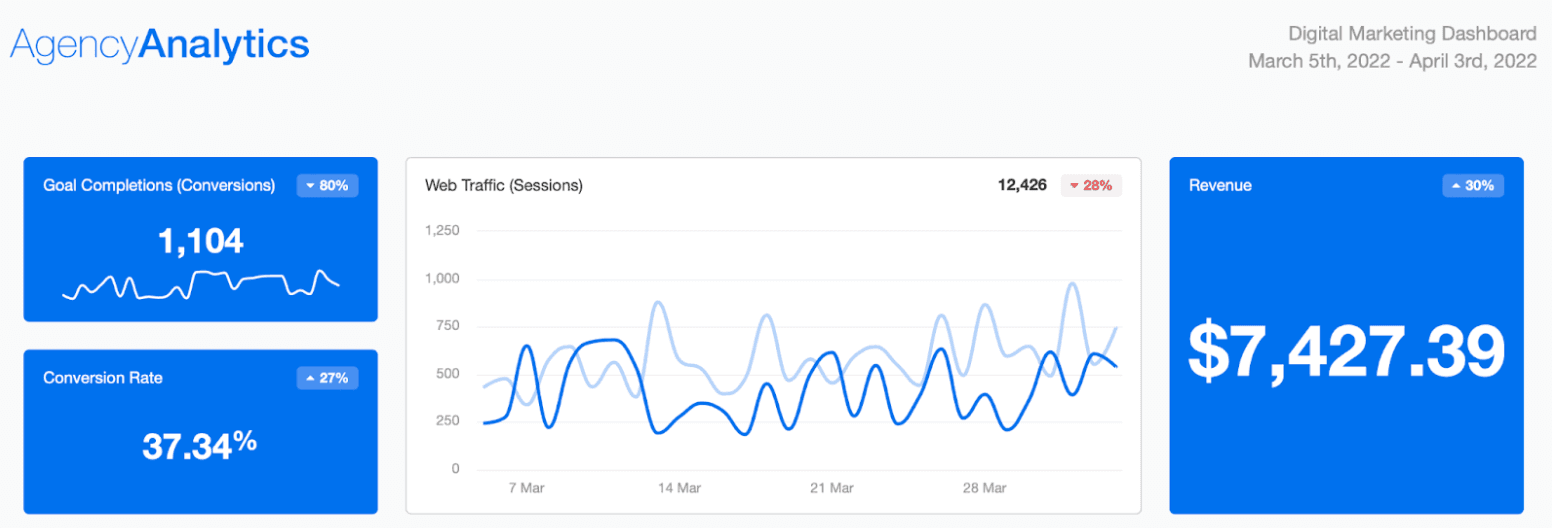
Scale your micro conversion tracking with AgencyAnalytics’ digital marketing dashboard today. Start your free 14-day trial.

Written by
Melody Sinclair-Brooks brings nearly a decade of experience in marketing in the tech industry. Specializing in B2B messaging for startups and SaaS, she crafts campaigns that cut through the noise, leveraging customer insights and multichannel strategies for tangible growth.
Read more posts by Melody Sinclair-BrooksSee how 7,000+ marketing agencies help clients win
Free 14-day trial. No credit card required.






